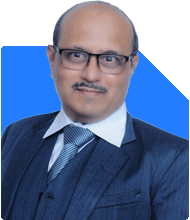Hello sir . I am 43. I want to invest in mutual funds.but which is the best and safest platform for investment sir.
Ans: Investing in mutual funds is a wise decision that can offer great growth potential. However, the choice of platform for investing is crucial. While online platforms have become popular, investing through a certified Mutual Fund Distributor (MFD) stands out for several reasons. I will discuss why choosing an MFD is often a better option, especially for Indian investors like you, and address some important aspects of mutual fund investments.
Let's walk through some critical points.
The Human Touch of MFDs vs. Online Platforms
Online platforms might look convenient at first glance. But they cannot replace the personalized, human touch of a professional MFD.
Certified Financial Planners and MFDs can give you tailored advice. They understand your unique financial goals and family needs.
Emotional guidance is another vital aspect that no online platform can provide.
Investing is not just about numbers. There are emotional ups and downs, especially in volatile markets. MFDs can help you remain calm during these times. This keeps you from making hasty or emotional decisions.
Online platforms are good for those who have deep knowledge of the markets. But for regular investors, a trusted human MFD is a better guide.
Actively Managed Funds Over Index Funds
Actively managed mutual funds are a great option for those looking for higher returns. Fund managers actively track the market and make decisions to beat the benchmark index. This personalized touch often brings in better returns, especially in markets like India.
Index funds, while simple and cheap, don't perform as well in volatile or emerging markets. They just mirror the market index, and there's no active management involved. This might work in developed markets, but in India, active funds often do better.
Also, index funds don’t give you protection during market crashes. When the market falls, the entire index fund value also falls. In contrast, actively managed funds can take defensive positions and protect your investment.
So, avoid getting attracted to the low-cost structure of index funds. It's better to focus on performance and risk management.
Regular Funds vs. Direct Funds
Another key decision is whether to invest in direct mutual funds or regular funds through an MFD.
Direct funds might seem cheaper because they don’t have distributor commissions. However, the hidden risk is that you’re on your own. You don’t get professional advice, which can cost you in the long term.
Regular funds come with professional guidance from an MFD, who helps you track your investments and advises when to buy or sell.
Most investors don’t have the time or expertise to track and rebalance their portfolios regularly. This is where an MFD steps in and makes life easier.
The small cost you pay for this service is well worth it in the long run, as you’ll likely earn better returns with sound advice.
The Importance of Diversification
Any good MFD will recommend diversification in your mutual fund investments. This means spreading your money across various sectors, asset classes, and fund types.
By diversifying, you reduce the risk of heavy losses. If one sector or asset class performs poorly, others can compensate.
For example, you can invest in equity, debt, and hybrid funds. Equity funds offer higher growth potential, while debt funds offer stability and safety. A mix of both gives a balanced approach.
An MFD helps you choose the right funds that align with your risk tolerance and goals. They will ensure you don’t put all your eggs in one basket, which online platforms rarely focus on.
Emotional Discipline in Volatile Markets
Investing through an MFD helps you maintain emotional discipline during volatile market conditions.
Online platforms can be tempting, as they allow you to react quickly to market changes. But this can lead to impulsive decisions like selling in panic during a market crash.
An MFD will help you stay calm, reminding you of the long-term strategy. This ensures you don’t make decisions based on short-term market noise.
Mutual fund investments should be treated like a marathon, not a sprint. Long-term patience often results in better returns.
Taxation of Mutual Funds: New Rules Explained
It’s also important to understand how mutual funds are taxed.
For equity mutual funds, Long-Term Capital Gains (LTCG) above Rs 1.25 lakh are taxed at 12.5%. Short-term capital gains (STCG) are taxed at 20%.
Debt mutual funds follow your income tax slab rates for both long-term and short-term gains.
It’s crucial to plan your investments keeping these tax rules in mind. A good MFD will help you optimize your investment plan to minimize tax liabilities. They can guide you on when and how to redeem your funds to reduce tax burdens.
The Role of Certified Financial Planners in Mutual Fund Investments
Certified Financial Planners (CFPs) add value by understanding your entire financial situation. They take a holistic approach, considering your goals, family needs, and risk appetite.
They are well-trained professionals who can guide you through life stages—whether you’re planning for retirement, your child's education, or saving for a big purchase.
A CFP will also consider your non-mutual fund investments, like PF, PPF, or insurance policies, to give you a comprehensive investment strategy.
They focus not only on wealth creation but also on wealth protection. If you have insurance policies that aren't performing well, a CFP can suggest alternatives like mutual funds to boost your returns.
Investment Strategy for Specific Goals
Investing in mutual funds should always align with your financial goals.
For example, if you’re saving for your child’s education, you may need a combination of equity and debt funds to match your time horizon. Equity funds will help you grow your investment, while debt funds will provide stability as you approach the goal.
If you're saving for retirement, an MFD can create a plan that balances risk and reward based on how many years you have left before retirement.
The key is to invest with a goal in mind. Random investments often lead to lower returns or missed opportunities.
Final Insights
Choosing the right platform and method for investing in mutual funds is a crucial decision. While online platforms offer convenience, they lack the personalized touch and emotional guidance that comes from an experienced MFD.
Investing is not just about numbers; it’s about staying disciplined, especially during market volatility. An MFD provides that extra layer of comfort and assurance, ensuring that your investments stay aligned with your goals.
By focusing on actively managed funds, regular plans, and maintaining emotional discipline, you can maximize your returns and reduce risks. Diversification, goal-based investing, and tax planning are essential parts of a successful investment strategy.
In conclusion, always remember that investing is a long-term journey. Choose a certified MFD to guide you through this journey with wisdom and care.
Best Regards,
K. Ramalingam, MBA, CFP,
Chief Financial Planner,
www.holisticinvestment.in
https://www.youtube.com/@HolisticInvestment

























